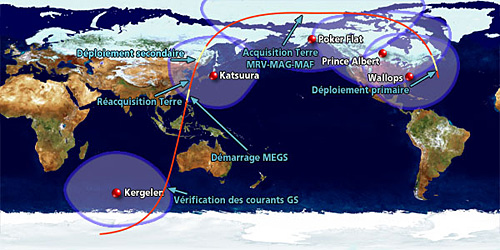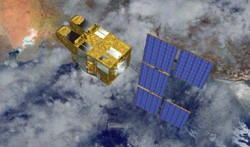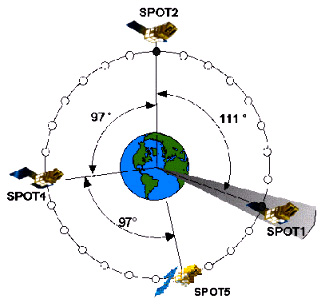![]()
Launch campaign
SPOT 5 will be launched from Europe's Kourou spaceport in French Guiana by an Ariane 42P rocket.
Because of its size, the satellite was shipped to the launch
site in three parts: the bus, payload and solar array.
The bus and payload were flown to Cayenne in an Airbus "Beluga" Super Transporter.
The solar array and ground support equipment were flown in a standard Air
France freight aircraft.
After unloading in Cayenne, the freight containers and ground support equipment were transported by road to the Guiana Space Centre (CSG). Checkout equipment was immediately installed and verified. The bus and payload were then assembled for electrical testing.
A full rehearsal is scheduled to perform final checks on operational procedures, involving the satellite and the Operations Control Centre (CMP) in Toulouse, France.
The solar array will then be mounted on the satellite and final thermal protection devices assembled. The satellite undergoes a health check before being transferred to a dedicated building for fuelling, assembly and encapsulation under the Ariane fairing.
Six days before launch, the satellite and fairing are transported to the launch tower and mated with the launch vehicle. A final health check is then conducted.
A final "launch" rehearsal is conducted three days before the health check, involving the satellite, CSG facilities, system ground segment and tracking station network.
Launch and first orbital revolutions
The launch sequence begins 12 hours before lift off. The satellite is put in launch configuration and the flight software uplinked. From this moment on, the satellite control facilities at the CSG take over until launch. Telemetry is sent to the CMP, which monitors operations and checks that the software has been loaded correctly.
The synchronized countdown starts six minutes before launch. The satellite is now operating autonomously and powered by its batteries.
After lift off, the CMP monitors the flight, solar array deployment, and attitude and orbit acquisition.
Once the satellite separates from the launch vehicle, the flight software activates an automatic sequence that is monitored by the control centre via the tracking station network. If an operation in this sequence goes wrong, the sequence is stopped and ground control takes over.

Critical operations during the first orbital revolution
When the satellite is within range of the Wallops Island station, just after separation, the gyros are switched on, mirrors are tilted to prevent direct sunlight entering the instruments, and primary deployment of the solar array is initiated by cutting the six pyrotechnic ties holding the panels firmly to the satellite structure.
|
Primary deployment of |
About four minutes after separation, the attitude acquisition phase begins with a first firing of the satellite's hydrazine microthrusters. Attitude acquisition is monitored by the stations at Saskatoon, Canada, and Poker Flat, Alaska.
|
Attitude acquisition |
Attitude acquisition operations are completed after about
25 minutes when the satellite is within view of the Japanese stations at Katsuuara
and Okinawa. The sequence is then stopped to allow the solar array to deploy
fully before the satellite is out of range.
|
Solar array deployment |
Operations resume about three minutes later, as soon as the correct deployment of the array is confirmed. The array's drive mechanism and the reaction wheels are then released. The reaction wheels are used later when the satellite switches to fine-pointing mode.
The satellite moves out of range of the Japanese stations about 37 minutes after separation. When it comes within sight of Kerguelen station 12 minutes later, the CMP checks that the solar array drive mechanism is tracking the Sun correctly. Controllers proceed with operations to put the satellite in its operational configuration. The critical phase is now over.
About three orbital revolutions later, the CMP commands the satellite to switch to operational mode. Its attitude is now controlled by the three reaction wheels and the orbit adjustment and in-orbit checkout phases can begin.

SPOT 5 in orbit, in Earth-pointing configuration
(artist's impression)
Orbit adjustment
SPOT 5's final orbital position is phased relative to the other SPOT satellites. However, SPOT 5 can only be injected directly into this position once every 26 days. To keep a launch window open on successive days, SPOT 5 will be injected into a holding orbit about 20 kilometres below the nominal orbit.
SPOT 5 reaches its final position after several days of controlled drift. Final orbit adjustment will then be performed to raise the spacecraft to the nominal altitude.

Final orbital position of SPOT 5 relative to SPOT 1, SPOT 2 and SPOT 4
In-orbit checkout
In-orbit checkout starts with the orbit adjustment phase and takes about two months.
The main aims of this phase are to:
- check that the satellite and all onboard systems and equipment are operating correctly,
- refine the instrument and satellite modulation transfer functions (MTF) used for image corrections,
- check image and product quality,
- verify system operation.
SPOT 5 products will also undergo thematic verification at the same time.
Thematic verification of SPOT 5 products
This phase aims to verify that acquired data will satisfy the main user requirements defined in the system specifications. Verification will involve experimental image acquisitions focusing on the use of SPOT 5's enhanced features (e.g., improved resolution and Supermode) in the most demanding thematic application areas.
These application areas will be those selected for the SPOT 5 Preparatory Programme pursued by CNES over the last three years. In mapping and urban planning, attention will focus on SPOT 5's ability to supply data for updating map databases and urban land-use databases. In forestry, where the resolution of previous SPOT satellites was considered inadequate, SPOT 5 data will be analysed to assess its usefulness for detecting change in forests badly damaged by the storms that swept across Europe in December 2000. A project also will be pursued to update environmental databases of the CORINE Land Cover kind, aimed at reaching new levels of accuracy. For example, SPOT 5 data will be used to count exact numbers of olive trees. End users will be closely involved in each of these projects.